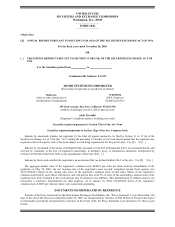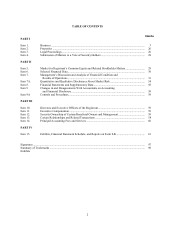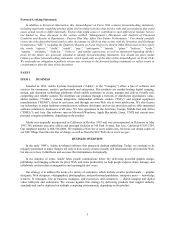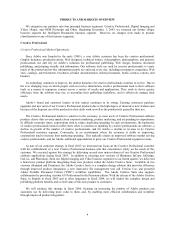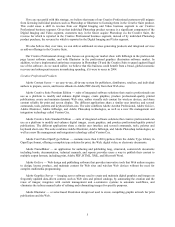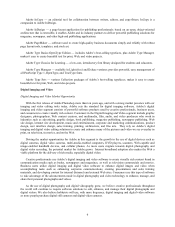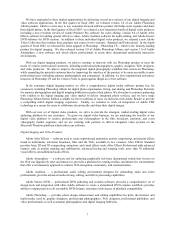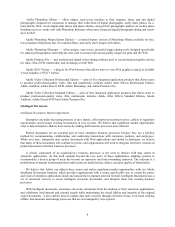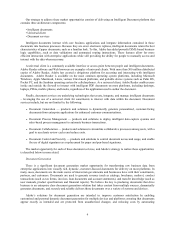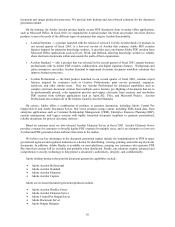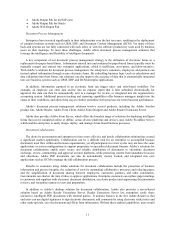Adobe 2003 Annual Report Download - page 9
Download and view the complete annual report
Please find page 9 of the 2003 Adobe annual report below. You can navigate through the pages in the report by either clicking on the pages listed below, or by using the keyword search tool below to find specific information within the annual report.9
Our strategy to address these market opportunities consists of delivering an Intelligent Document platform that
contains three architecture components:
• Intelligent documents
• Universal client
• Document services
Intelligent documents interact with core business applications and integrate information contained in those
documents into business processes. Because they are exact electronic replicas, intelligent documents retain the best
characteristics of paper documents, such as a familiar look. To this, Adobe has added powerful XML-based business
logic capabilities, such as data validations and automated routing instructions. These features allow for more
efficient interaction with enterprise applications while still providing the ability for people to manually access and
interact with the data when necessary.
A universal client is a commonly available interface or access point between people and intelligent documents.
Adobe Reader software and Web browsers are examples of universal clients. With more than 500 million distributed
copies of Adobe Reader, Adobe has created a ubiquitous platform for accessing and interacting with intelligent
documents. Adobe Reader is available on the most common operating system platforms, including Microsoft
Windows, Apple Macintosh, Linux, various Unix-based platforms, and portable device systems such as Palm OS,
Pocket PC, and the Symbian operating system for cellular phones. As a universal client, Adobe Reader enables users
inside and outside the firewall to interact with intelligent PDF documents on most platforms, including desktops,
laptops, PDAs, mobile phones, and kiosks, regardless of the application used to author the document.
Finally, document services are underlying technologies that create, integrate, and manage intelligent documents
– leveraging the use of a universal client for constituents to interact with data within the document. Document
services include, but are not limited to, the following:
• Document Generation — products and solutions to dynamically generate personalized, customer-facing
documents from enterprise applications for enhanced customer communications.
• Document Process Management — products and solutions to deploy intelligent data capture systems and
rules-based process management to automate business transactions.
• Document Collaboration — products and solutions to streamline collaborative processes among users, with a
goal to accelerate review cycles and reduce costs.
• Document Control and Security — products and solutions to control document access and usage, and enable
the use of digital signatures as a replacement for paper and pen-based signatures.
The market opportunity for each of these document services, and Adobe’s strategy to realize these opportunities
is described below in more detail.
Document Generation
There is a significant document generation market opportunity for transforming raw business data from
enterprise applications into visually rich, dynamic, customer-focused documents for delivery on most platforms. In
many cases, documents are the main source of interaction governments and businesses have with their constituents,
partners, and customers. Documents are used to generate revenue (such as catalogs, brochures, mailers), conduct
transactions (such as tax forms, invoices, loan documents and account statements), and transfer knowledge (such as
user manuals, product specifications and financial reports). We believe the key to producing documents that drive
business is an enterprise class document generation solution that takes content from multiple sources, dynamically
generates documents, and securely and reliably delivers those documents over a variety of systems and devices.
Adobe’s solutions for document generation are intended to: improve customer satisfaction by enabling
customized and personal dynamic document generation for multiple devices and platforms; ensuring that documents
appear exactly as intended and are protected from unauthorized changes; and reducing costs by automating

